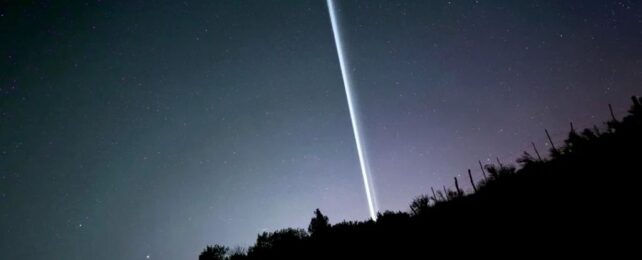On the night of Saturday 17 May, skywatchers across the US as far south as New Mexico were treated to a peculiar sight: a brilliant stream of whitish light, stretching across the sky.
That was a night for auroral activity, as Earth's magnetic field was buffeted by an influx of particles ejected from the Sun several days earlier. Initially, explanations favored STEVE, the name given to the white-mauve streaks of light emitted by rivers of charged particles flowing through Earth's ionosphere.
STEVE is not an aurora, but, like the auroral displays it often appears alongside, is also a product of space weather.
Spoiler though: the light was not actually STEVE, but a rocket stage dumping out methalox rocket fuel at an altitude of about 250 kilometers (155 miles), bang in the ionosphere, according to astronomer Jonathan McDowell, who tracks activity in Earth space.
TLEs confirm the Zhuque-2 upper stage passed over the US Four Corners area at 0525 UTC May 17 and is the source of the unusual luminous cloud seen by many observers.
— Jonathan McDowell (@planet4589) May 17, 2025
At 04:12 UTC, Beijing-based startup LandSpace Technology launched its new Zhuque-2E Y2 methane-fueled carrier rocket, bearing six satellites into Earth orbit. About an hour later, the bright stripe appeared in the sky – not far from midnight over much of the US. That stripe, according to McDowell, was the result of a fuel dump from the rocket's upper stage.
Rocket fuel made from methane and liquid oxygen, known as methalox, is a relatively recent development; LandSpace was the first company to successfully launch a methalox rocket, back in 2023, and this is the fifth flight for its Zhuque-2 series, the company said in a statement.
Methalox is attractive to the aerospace industry because it is cheaper, cleaner, and easier to store, and it may be able to be produced on Mars. That would make crewed missions to the red planet more efficient, since the spacecraft would not need to carry the fuel for the return journey from the outset.
"Fuel dump from Zhuque-2 upper stage, at about 250 km altitude" said @planet4589 https://t.co/xihoyJMzoQ pic.twitter.com/yLdPRfxJCR
— Tom Bike (@tom_bike) May 19, 2025
Rocket fuel can glow in the upper atmosphere through several mechanisms. One, seen close to twilight hours, is the illumination of ice particles by the light of the Sun. Closer to midnight, the Sun would be too far around the other side of Earth to be able to illuminate particles, even those high in the atmosphere.
In the ionosphere, molecules involving carbon, hydrogen, and oxygen can generate chemical reactions that produce light. Carbon and hydrogen are the components of methane.
This plume was not an aurora, and it was not STEVE. We believe it is related to a rocket launch in China. About an hour before the plume appeared (5:39 UTC), Chinese launch startup Landspace launched the ZhuQue-2E rocket from the Jiuquan Satellite Launch Center (4:12 UTC). It… pic.twitter.com/FEcwhfxbZT
— Oppenheimer Ranch Project (@Diamondthedave) May 17, 2025
"The reactions [of rocket fuel] with the plasma in the ionosphere include ion-molecule charge exchange, electron-ion recombination, and optical emissions from chemiluminescence," a team of physicists led by Paul Bernhardt of the US Naval Research Laboratory explained in a 2012 paper.
"If the plume is fired into the ionosphere at night, chemiluminescent reactions with ion-molecule charge exchange followed by electron-ion dissociative recombination yield a long-lived glow that can be observed from ground or space."
Anybody know what this light could be?
byu/Ambitious_Amount_357 inAstronomy
Usually, the glowing fuel of a rocket blasting into space manifests as a strange spiral in the sky. Rocket fuel masquerading as STEVE is a new experience, but it sure is pretty.
Methalox is gaining traction, with more rocket companies investigating its use. Perhaps more such streaks will appear in the sky. If you see one, now you might know what you're looking at.
